Saudia
 | |||||||
| |||||||
| Founded | September 1945 | ||||||
|---|---|---|---|---|---|---|---|
| Hubs | |||||||
| Frequent-flyer program | Al Fursan Loyalty | ||||||
| Alliance | SkyTeam | ||||||
| Subsidiaries | Flyadeal | ||||||
| Fleet size | 187 | ||||||
| Destinations | 127[1] | ||||||
| Company slogan | Welcome to your world! | ||||||
| Parent company | Saudi Arabian government | ||||||
| Headquarters | Jeddah, Saudi Arabia | ||||||
| Key people |
| ||||||
| Website | saudia.com | ||||||
Saudia (Arabic: السعودية as-Suʿūdiyyah), also known as Saudi Arabian Airlines (الخطوط الجوية العربية السعودية), is the national carrier[2] airline of Saudi Arabia, based in Jeddah.[3] The airline's main operational base is at King Abdulaziz International Airport in Jeddah. King Khalid International Airport in Riyadh and King Fahd International Airport in Dammam are secondary hubs. The new Dammam airport was opened for commercial use on 28 November 1999. Dhahran International Airport in use until then, has reverted to being used as a military base. The airline is the third largest in the Middle East in terms of revenue, behind Emirates and Qatar Airways.[4] It operates domestic and international scheduled flights to over 120 destinations in the Middle East, Africa, Asia, Europe and North America. Domestic and international charter flights are operated, mostly during the Ramadan and the Hajj season. Saudia is a member of the Arab Air Carriers Organization and joined the SkyTeam airline alliance on 29 May 2012.
History
Early years


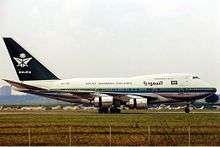

When U.S. President Franklin Delano Roosevelt presented a Douglas DC-3 as a gift to King Abdul Aziz Ibn Saud in 1945, the event marked the Kingdom's gradual development of civil aviation. The nation's flag carrier, Saudia, was founded as Saudi Arabian Airlines in September 1945[5] as a fully owned government agency under the control of the Ministry of Defense, with TWA running the airline under a management contract.
From the beginning until the end, Jeddah-Kandara airport—very near the town center-served as the flag carrier's main base. Among the airline's early operations was a special flight from Lydda in Palestine (today Lod in Israel, site of Ben-Gurion International Airport), a British Mandate at that time, to carry Hajj pilgrims to Jeddah. The airline used five DC-3 aircraft to launch scheduled operations on the Jeddah-Riyadh-Hofuf-Dhahran route in March 1947, followed by its first international service between Jeddah and Cairo in the same month. Service to Damascus and Beirut followed in early 1948. The following year the first of five Bristol 170s was received. These aircraft offered the airline the flexibility of carrying both passengers and cargo.
In 1962, the airline took delivery of two Boeing 720s, becoming the fourth Middle Eastern airline to fly jet aircraft, after Middle East Airlines and Cyprus Airways with the de Havilland Comet in 1960 and El Al with the Boeing 707 in 1961.[6] On 19 February 1963, the airline became a registered company, with King Faisal of Saudi Arabia signing the papers that declared Saudia a fully independent company. DC-6s and Boeing 707s were later bought, and the airline joined the AACO, the Arab Air Carriers Organization. Services were started to Sharjah, Tehran, Khartoum, Mumbai, Tripoli, Tunis, Rabat, Geneva, Frankfurt, and London.
In the 1970s, a new livery was introduced. The carrier's name was changed to Saudia on 1 April 1972. Boeing 737s and Fokker F-28s were bought, with the 737s replacing the Douglas DC-9. The airline operated their first Boeing 747s service in 1977 when three Jumbo Jets were leased from Middle East Airlines and deployed on the London sector. The first all-cargo flights between Saudi Arabia and Europe were started, and Lockheed L-1011s and Fairchild FH-27s were introduced. New services, including the Arabian Express 'no reservation shuttle flights' between Jeddah and Riyadh. The Special Flight Services (SFS) was set up as a special unit of Saudia, and operates special flights for the Royal family and government agencies. Service was also started to Rome, Paris, Muscat, Kano, and Stockholm. The Pan Am/Saudia joint service between Dhahran and New York City started on 3 February 1979.
In the 1980s services such as Saudia Catering began. Flights were started to Athens, Bangkok, Dhaka, Mogadishu, Nairobi, New York City, Madrid, Singapore, Manila, Delhi, Islamabad, Seoul, Baghdad, Amsterdam, Colombo, Nice, Lahore, Brussels, Dakar, Kuala Lumpur and Taipei. Horizon Class, a business class service, was established to offer enhanced service. Cargo hubs were built at Brussels and Taipei. Airbus A300s, Boeing 747s, and Cessna Citations were also added to the fleet, the Citations for the SFS service. In 1989 services to Larnaca and Addis Ababa began. On July 1, 1982, the first nonstop service from Jeddah to New York City was initiated with Boeing 747SP aircraft. This was followed by a Riyadh-New York route.
In the 1990s, services to Orlando, Chennai, Asmara, Washington, D.C., Johannesburg, Alexandria, Milan, Málaga (seasonal), and Sanaa (resumption) were introduced. Boeing 777s, MD-90s and MD-11s were introduced. New female flight attendant uniforms designed by Adnan Akbar were introduced. A new corporate identity was launched on 16 July 1996, featuring a sand colored fuselage with contrasting dark blue tailfin, the center of which featured a stylized representation of the House of Saud crest. The Saudia name was dropped in the identity revamp, with Saudi Arabian Airlines name used.
Development since the 2000s
On 8 October 2000, Prince Sultan bin Abdulaziz Al Saud, the Saudi Minister of Defense and Aviation, signed a contract to conduct studies for the privatization of Saudi Arabian Airlines. In preparation for this, the airline was restructured to allow non-core units—including Saudia catering, ground handling services and maintenance as well as the Prince Sultan Flight Academy in Jeddah—to be transformed into commercial units and profit centers. In April 2005, the Saudi government indicated that the airline may also lose its monopoly on domestic services.[7]
Saudi Arabian Airlines achieved operational profits in 2002, which doubled in 2003, but the profits were primarily due to over one billion riyals on deferred income amortised annually in the income statement, courtesy of the 70 aircraft gifted to the airline by the Saudi government. In 2004, the airline carried over 15 million passengers and recorded a 14% rise in profits. In April the following year the airline ordered 15 Embraer E-170LR aircraft in a deal worth $400 million.
In 2006, Saudia began the process of dividing itself into Strategic Business Units (SBU); the catering unit was the first to be privatized.[8] In August 2007, Saudi Arabia's Council of Ministers approved the conversion of strategic units into companies. It is planned that ground services, technical services, air cargo and the Prince Sultan Aviation Academy, medical division, as well as the catering unit, will become subsidiaries of a holding company.[9]
The airline reverted to its abbreviated English brand name Saudia (used from 1972 to 1996) from Saudi Arabian Airlines (historic name in use until 1971 and reintroduced in 1997) on 29 May 2012; the name was changed to celebrate the company's entry into the SkyTeam airline alliance on that day, and it was a part of a larger rebranding initiative.[10]
Saudia received 64 new jets by the end of 2012 (6 from Boeing and 58 from Airbus). Another 8 Boeing 787-9 aircraft started to join the fleet in 2015.[11]
In April 2016, Saudia announced the creation of a low-cost subsidiary, Flyadeal. The airline was launched as part of Saudia Group's SV2020 Transformation Strategy, which intends to transform the group's units into world-class organisations by 2020. Flyadeal will serve domestic and regional destinations, beginning flights in mid-2017.[12]
Destinations
Codeshare agreements
Saudia has codeshare agreements with SkyTeam partners and with the following airlines:[13]
Fleet
Current fleet

.jpg)
.jpg)
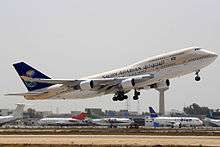

.jpg)
As of August 2017, the Saudia fleet consists of the following aircraft including its passenger and cargo fleet:[14][15]
| Saudia Fleet | |||||||
| Aircraft | In service | Orders | Passengers | Notes | |||
|---|---|---|---|---|---|---|---|
| F | J | Y | Total | ||||
| Airbus A320-200 | 43 | 2 | – | 12 | 120 | 132 | HZ-ASF in Skyteam Livery, 3 stored |
| 20 | 96 | 116 | |||||
| 12 | 132 | 144 | |||||
| Airbus A321-200 | 15 | — | – | 20 | 145 | 165 | |
| Airbus A330-200 | 8 | — | NYA | Leased from Onur Air | |||
| Airbus A330-300 | 12 | — | – | 36 | 262 | 298 | HZ-AQL in Skyteam Livery, HZ-AQE in Saudi National Day Livery |
| 252 | 288 | ||||||
| 16 | 3 | – | 30 | 300 | 330 | Launch operator of A330 Regional | |
| Boeing 747-400 | 7 | — | NYA | Leased from Air Atlanta Icelandic | |||
| Boeing 777-200ER | 22 | — | 24 | 38 | 170 | 232 | HZ-AKA in Skyteam Livery, 10 stored |
| – | 14 | 327 | 341 | ||||
| Boeing 777-300ER | 35 | — | 12 | 36 | 242 | 290 | HZ-AK28 in Famous Saudi Arabian Landmarks special livery |
| 24 | 245 | 305 | |||||
| – | 30 | 351 | 381 | ||||
| 383 | 413 | ||||||
| Boeing 787-9 | 10 | 1 | – | 24 | 274 | 298 | |
| Saudia Cargo Fleet | |||||||
| Boeing 747-400BDSF | 5 | — | Operated by Air Atlanta Icelandic and MyCargo Airlines.[16] | ||||
| Boeing 747-400F | 2 | — | Each Operated by Air Atlanta Icelandic and MyCargo Airlines | ||||
| Boeing 747-400ERF | 2 | — | Operated by MyCargo Airlines.[16] | ||||
| Boeing 747-8F | 2 | — | |||||
| Boeing 777F | 4 | — | |||||
| Saudia Albayraq | |||||||
| Airbus A319-100 | 3 | — | – | 48 | – | 48 | Operates between Jeddah and Riyadh [17] Leased from PrivatAir |
| Total | 187 | 6 | |||||
Historic fleet
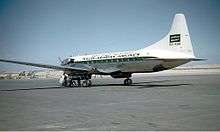
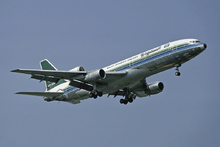
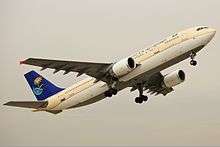
Saudia formerly operated the following aircraft:[18]
| Aircraft | Total | Introduced | Retired | Notes |
|---|---|---|---|---|
| Airbus A300-600 | 11 | 1984 | 2012 | |
| Airbus A310-300F | 1 | 2010 | 2013 | |
| Airbus A319-100 | 2 | 2007 | 2017 | Leased from Czech Airlines |
| Airbus A340-300 | 4 | 1999 | 2014 | |
| Boeing 707-320 | Unknown | 1968 | 1987 | |
| Boeing 727-100 | 1 | 1976 | 2000s | Operated for Saudi Arabian Royal Flight |
| Boeing 737-200 | 26 | 1972 | 2007 | |
| Boeing 747-100 | 19 | 1981 | 2010 | |
| Boeing 747-200 | 33 | 1979 | 2012 | |
| Boeing 747-200F | 7 | 1981 | 2012 | |
| Boeing 747-300 | 18 | 1985 | 2013 | Eight aircraft stored |
| Boeing 747-300SF | 1 | 2014 | 2015 | |
| Boeing 747-400 | 14 | 1997 | 2016 | |
| Boeing 747SP | 2 | 1981 | 1992 | |
| Boeing 757-200 | 10 | 2008 | 2011 | |
| Boeing 767-200ER | 5 | 2003 | 2012 | |
| Boeing 767-300ER | 6 | 2012 | 2012 | |
| Convair 340 | Unknown | 1960s | 1970s | |
| Embraer ERJ-170 | 15 | 2005 | 2016 | All aircraft stored |
| Fokker F28 | Unknown | 1977 | 1980s | |
| Lockheed L1011 Tristar | 24 | 1977 | 1998 | |
| Lockheed L1011 Tristar 500 | 2 | 1970s | Unknown | Operated for Saudi Arabian Royal Flight |
| McDonnell Douglas DC-8 series | 37 | 1977 | 1998 | |
| McDonnell Douglas DC-9 | 3 | 1967 | 1972 | |
| McDonnell Douglas DC-10 | 1 | 1975 | 1990s | |
| McDonnell Douglas MD-11F | 4 | 1998 | 2014 | All aircraft stored |
| McDonnell Douglas MD-11 | 2 | 1998 | 2013 | Operated for Saudi Arabian Royal Flight |
| McDonnell Douglas MD-90 | 29 | 1998 | 2013 | Two aircraft stored |
Other aircraft
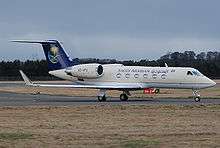
Saudia Special Flight Services, VIP flights, and Private Aviation operate the following, a number of which sport the airline's livery
- 6 Beechcraft Bonanza (training)
- 2 Dassault Falcon 900 (government use)
- 4 Dassault Falcon 7X (charter)
- 6 Gulfstream IV (government use)
- 6 Hawker 400XP (government use)
Some military C-130s are also painted with the Saudia colors and are flown by Royal Saudi Air Force crews to support Saudi official activities in the region and Europe.
In-flight services
The inflight magazine of Saudia is called Ahlan Wasahlan (Arabic: أهلاً وسهلاً "Hello and Welcome"). No alcoholic beverages[19] or pork are served on board in accordance with Islamic dietary laws. Its selected Airbus A330-300 and Boeing 777-300ER aircraft are equipped with Wi-Fi and mobile network portability on board. Some aircraft also offer onboard specialized prayer areas.[20]
Incidents and accidents
- On 25 September 1959, a Saudia Douglas DC-4/C-54A-5-DO (registration HZ-AAF), performed a belly landing shortly after take-off from the old Jeddah Airport. The cause of the accident was gust locks not deactivated by the mechanic, followed by a stall. All 67 passengers and 5 crew survived.[21]
- On 9 February 1968, a Douglas C-47 (Registration HZ-AAE) was damaged beyond economic repair at an unknown location.[22]
- On 10 November 1970, a Douglas DC-3 on a flight from Amman Civil Airport, Jordan to King Khalid International Airport, Riyadh, Saudi Arabia was hijacked and diverted to Damascus Airport, Syria.[23]
- On 11 July 1972, a Douglas C-47B (Registration HZ-AAK) was damaged beyond economic repair in an accident at Tabuk Airport.[24]
- On 19 August 1980, Saudia Flight 163, a Lockheed L-1011-200 TriStar, operating Karachi-Riyadh-Jeddah, was completely destroyed by fire at Riyadh airport with the loss of all 301 people on board due to delays in evacuating the aircraft. This was the deadliest accident experienced by Saudia until 312 were killed in the loss of Flight 763 over 16 years later.
- On 22 December 1980, Saudia Flight 162, a Lockheed L-1011-200 TriStar, operating Dhahran to Karachi, experienced an explosive decompression, penetrating the passenger cabin. The hole sucked out two passengers and depressurized the cabin.[25]
- On 5 April 1984, a Saudia Lockheed L-1011 TriStar on final approach to Damascus from Jeddah was hijacked by a Syrian national. The hijacker demanded to be taken to Istanbul, Turkey but changed his mind and requested to go to Stockholm, Sweden. After landing in Istanbul to refuel, the hijacker was arrested after the pilot pushed him out of the emergency exit.[26]
- On 12 November 1996, a Saudia Boeing 747-100B, operating flight 763, was involved in the 1996 Charkhi Dadri mid-air collision. The aircraft was on its way from New Delhi, India, to Dhahran, Saudi Arabia when a Kazakhstan Airlines Ilyushin Il-76 collided with it over the village of Charkhi Dadri, some miles west of New Delhi. Flight 763 was carrying 312 people, all of whom, along with 37 more on the Kazakh aircraft, died, for a grand total of 349 fatalities. The loss of Flight 763 alone remains Saudia's worst accident in terms of fatalities. The accident overall also remains the world's deadliest mid-air collision and the third-deadliest aviation disaster in history, as well as the deadliest one with no survivors.
- On 14, October 2000, Saudi Arabian Airlines Flight 115,[27] flying from Jeddah to London was hijacked en route by two men who claimed they were armed with explosives. The hijackers commandeered the Boeing 777-200 to Baghdad, Iraq, where all 90 passengers and 15 crew members were safely released. The two hijackers, identified as Lieutenant Faisal Naji Hamoud Al-Bilawi and First Lieutenant Ayesh Ali Hussein Al-Fareedi,[28] both Saudi citizens, were arrested and later extradited to Saudi Arabia in 2003.[29][30]
- On 23 August 2001, at Kuala Lumpur International Airport, Malaysia, a Boeing 747-300 (Registration HZ-AIO) suffered nose damage as it entered a monsoon drainage ditch while it was being taxied by Maintenance staff from the hangar to the gate before a return flight to Saudi Arabia. None of the six crew members on board at the time were injured.[31]
- On 8 September 2005, a Boeing 747 traveling from Colombo to Jeddah, carrying mostly Sri Lankan nationals to take up employment in the Kingdom, received a false alarm claiming that a bomb had been planted on board. The aircraft returned to Colombo. During the evacuation, there was a passenger stampede in the wake of which one Sri Lankan woman died, 62 were injured, and 17 were hospitalized. The aircraft had taken on a load of 420 passengers in Colombo.[32] According to the Civil Aviation Authority of Sri Lanka, the probable cause was a "Breakdown of timely and effective communication amongst Aerodrome Controller and Ground Handling (SriLankan Airlines) personnel had prevented a timely dispatch of the stepladders to the aircraft to deplane the passengers in a timely manner, which resulted in the Pilot-In-Command to order an emergency evacuation of the passengers through slides after being alarmed by the bomb threat."[33]
- On 25 May 2008, a leased aircraft operating under Saudi Arabian Airlines as Flight SV-806 from Prince Mohammad Bin Abdulaziz Airport, Madinah made an unscheduled landing at Zia International Airport (now Shahjalal International Airport), Dhaka. During the roll the tower controller reported that he saw a fire on the right hand wing. Upon vacating the runway, the crew received a fire indication for engine number three. The fire extinguisher was activated and all engines were shut down. The aircraft, a Boeing 747-357, which was damaged beyond repair, was successfully evacuated.[34] Only minor injuries were incurred.[35] Investigations revealed a fuel leak where the fuel enters the front spar for engine number three.[34]
- On 5 January 2014, a leased Boeing 767 operating under Saudia was forced to make an emergency landing at Prince Mohammad bin Abdulaziz Airport in Medina after landing gear failed to deploy. 29 people were injured in the incident.[36][37]
- On 5 August 2014, a Boeing 747-400 (reg. HZ-AIX) operating as flight 871 from Manila to Riyadh veered off the runway 24 of Ninoy Aquino International Airport in Manila while positioning for takeoff. No one on the plane or on ground were injured.[38]
References
- ↑ Network Map Saudia. Retrieved 17 January 2013.
- ↑ Hofmann, Kurt (20 January 2017). "Saudia outlines 2017 fleet delivery plan". Air Transport World. Archived from the original on 21 January 2017.
Saudi Arabia’s national carrier Saudia will take delivery of 30 aircraft this year, according to a Jan. 17 statement.
- ↑ "Saudi Arabian Airlines Ground Services Company: Private Company Information". Businessweek. Retrieved 3 September 2012.
- ↑ Reed Business Information Limited. "Airline Business top 100 airlines rankings - Middle East". Retrieved 24 April 2015.
- ↑ "Economy and Infrastructure" (PDF). Saudi Embassy. Retrieved 5 September 2014.
- ↑ "Commercial Aviation". centennialofflight.gov. Retrieved 29 May 2017.
- ↑ "Embraer wins $400m Saudi jet deal". BBC News. 28 March 2006. Retrieved 27 September 2010.
- ↑ "Saudi Air Lauches [sic] Privatization With Catering Unit". Retrieved 14 September 2007.
- ↑ "Saudi cabinet okays Saudi Arabian Airlines privatisation". Retrieved 14 September 2007.
- ↑ "Arabian Aerospace - Saudia plays the name game, joins the alliance and gets privatisation rolling". Arabian Aerospace. 29 May 2012. Retrieved 28 January 2013.
- ↑ "Our Fleet". Retrieved 24 April 2015.
- ↑ Hanware, Khalil (19 April 2016). "Flyadeal's launch puts Saudia at higher altitude". Arab News. Jeddah. Retrieved 20 April 2016.
- ↑ "Profile on Saudia". CAPA. Centre for Aviation. Archived from the original on 2016-10-31. Retrieved 2016-10-31.
- ↑ "Saudia Fleet". www.saudiairlines.com. 26 January 2017. Retrieved 27 January 2017.
- ↑ "SAUDIA Fleet". www.planespotters.net. 3 August 2017. Retrieved 1 July 2017.
- 1 2 "Saudia to wet-lease two more B747-400 freighters". ch-aviation. Retrieved 24 April 2015.
- ↑ "SAUDIA Albayraq". www.spa.sa. Retrieved 12 September 2016.
- ↑ Saudi Arabian Airlines Fleet Details and History Plane Spotters. Retrieved 5 September 2014.
- ↑ "Major Airlines that Don't Serve Alcohol". ShawnVoyage.
- ↑ "Mobile & WiFi". Retrieved 24 April 2015.
- ↑ "Saudi Arabian Airlines DC-4 accident HZ-AAF". Aviation-safety.net. Retrieved 16 March 2010.
- ↑ "HZ-AAE Accident description". Aviation Safety Network. Retrieved 24 July 2011.
- ↑ "Hijacking description". Aviation Safety Network. Retrieved 20 October 2010.
- ↑ "HZ-AAK Accident description". Aviation Safety Network. Retrieved 5 September 2010.
- ↑ "Accident Database: Accident Synopsis 12231980". Air Disaster. 23 December 1980. Retrieved 28 January 2013.
- ↑ Hijacking description at the Aviation Safety Network
- ↑ "Saudi hijack passengers freed". BBC World. 14 October 2000. Retrieved December 25, 2010.
- ↑ "Hijacked Saudi plane returns safely to Riyadh". Saudi Embassy. 2000-09-16. Retrieved December 25, 2010.
- ↑ "Saudi Hijacker Extradited". USA Today. 18 November 2003. Retrieved December 25, 2010.
- ↑ Hijacking description at the Aviation Safety Network
- ↑ "Accident information: Boeing 747 Saudi Arabian Airlines HZ-AIO". Airfleets. Retrieved 27 September 2010.
- ↑ "Bomb hoax triggers panic at Sri Lanka airport Archived 11 June 2008 at the Wayback Machine.," Asian Political News. 12 September 2005
- ↑ "Final report: Accident of Saudi Arabian Airlines Flight SV-781, Boeing 747-368, Registration HZ-AIP, oN 08 September 2005 at Bandaranaike International Airport, Katunayake – Sri Lanka" (Archive) Civil Aviation Authority of Sri Lanka. p. 11. Retrieved 3 May 2013.
- 1 2 "ASN Aircraft accident Boeing 747-357 TF-ARS Dhaka-Zia International Airport (DAC)". Aircraft Safety Network. Retrieved 24 January 2010.
- ↑ "Saudi plane catches fire at ZIA". The Daily Star. 26 March 2008. Retrieved 24 January 2011.
- ↑ "Plane Crash Lands in Saudi Holy City". The Wall Street Journal.
- ↑ "Saudi Plane Makes Emergency Landing, 29 Hurt". Gulf Business. Reuters. 5 January 2014. Retrieved 17 January 2014.
- ↑ "Saudia plane overshoots NAIA runway (MNL)". ABS CBN News. Retrieved 5 August 2014.
External links
![]() Media related to Saudi Arabian Airlines at Wikimedia Commons
Media related to Saudi Arabian Airlines at Wikimedia Commons